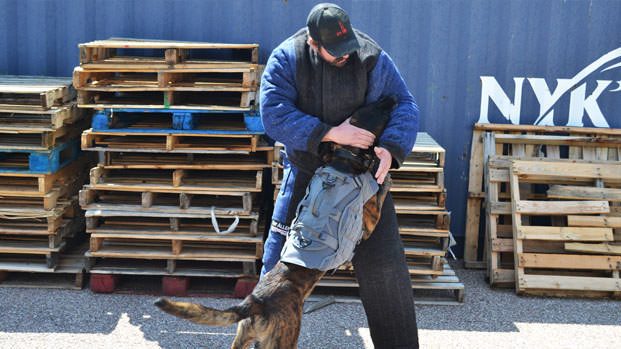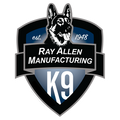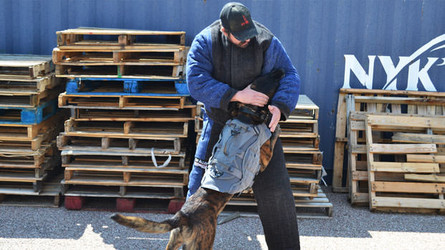K9 Dog Bite Work Training Guide For Police and Military
Jun 15th 2016

by Mike Suttle
I constantly see police dogs who lack a lot of confidence in the patrol and apprehension phase of their work, as well as dogs that will take very little real pressure from a man while they are engaged in a fight. I believe that most of these issues could have been avoided through proper K-9 selection in the first place because a lot of these dogs are simply not genetically cut out to do this type of work. However even if the young green dog was properly selection tested and proved to have the genetic qualities required to make a strong street dog, often times the trainers lack the skill and ability to bring out the dog’s true genetic potential. There are very few dogs, regardless of genetic makeup who will bring a fight to a man and stay engaged in that fight regardless of the amount of personal, environmental, and physical pressure that man brings to the dog, without first receiving proper training and learning to develop that skill set.
Let’s assume here that the dog was properly selection tested and it does have all the necessary qualities required to be a strong patrol dog. Otherwise it really won’t matter how good we are as trainers, as the dog’s genetic potential will be the limiting factor in our success as a team. So if we assume the dog has “what it takes” to do the work, how do we prepare him to handle a real fight?
First, I would like to take a quick look into what we often see during a patrol training event. The dog is taken from the vehicle and walked onto the training field. The dog is enthusiastic about getting to bite and often times he is trying to drag his handler onto the field. The handler gives the dog harsh corrections and commands him to “heel,” sometimes several times as they approach the field. Now the dog is told to bite the decoy, which is often times just another officer in a suit, and not necessarily a skilled decoy. The decoy, without knowing any better, pushes the dog around, overpowers him, and even worse, the decoy doesn’t recognize the dog’s attempts to counter in and show forward power and therefore doesn’t reinforce that behavior in the dog. Instead, he punishes that behavior by applying more pressure and never allowing the dog to be successful. Now the handler comes up, commands the dog to out, beats him up for not outing right away, and forces him to heel back to the car. During this entire training event, the dog gets no chance of success from the time he comes out of the car until the time he goes back into the car. He had to worry about fighting his handler onto the field, had to worry about never being able to control the decoy while he was biting, then his handler came up and he had to worry about him again. And this scenario, or one similar to this one happens every time the dog comes out to do patrol work training. I know many readers will say “this is not the way we do it,” but I have seen this in some form or another so many times that it is, in fact, the way far too many teams do it.
The first and most important thing that you MUST have is a skilled decoy. I can’t stress that enough. The dog needs to be taught to bite the man, not the suit. He must learn to go forward when the stress level from his opponent increases. He must be conditioned to believe that no matter what happens in this fight, the path to success is to bite harder, show more commitment to the fight, and drive harder into the man. None of these things can be taught by an inexperienced decoy, and therefore the dog can never learn them by training with that type of decoy. Furthermore, the dog has to believe that anytime his handler approaches the dog while he is fighting that the handler is there to help him overpower the decoy, not create stress by always commanding the dog to out and often times accompanying that with a harsh correction.
Let’s take a look at the type of bite suit that will be used in training. Leave the big super thick, heavyweight “police dog training suit” in the closet. In order to communicate with the dog, the decoy must be able to feel everything the dog is “telling” him. This is impossible with a heavyweight suit. So if you are afraid of getting badly bruised, severely lumped up, and sometimes bleeding, then being a good training decoy is not for you. Work the dog in a properly fitting light weight, or competition weight suit with no gauntlet or any type of wrap under the suit. This will allow you to truly feel what the dog is doing and this is the only way to fully understand what effect your reactions have on the dog. DO NOT try to roll your body out of the dog’s mouth and leave him only with suit material in his mouth. Your goal is to teach the dog to “hunt” for the man inside the suit, not to teach him to just fill his mouth with a large bulk of suit material. And when he “finds” you in the suit, react to that, let him know that finding and biting the man in the suit has an effect on you, while merely biting the suit itself has no effect on you at all. We are trying to encourage a full grip and when we achieve this, the pain you feel as the decoy is actually less than the pain associated with a shallow grip that will pinch. But no matter how the dog is biting it is critical that we always teach him to find and bite the man inside the suit, and not just the suit itself.
Now let’s take a look at the different types of pressures that we can show a dog. I break these down into three types:
- Personal pressure - This is any pressure that comes from the man that does not involve physical contact with the dog. Examples would be posturing, strong eye contact, puffing the chest, flaring of the nostrils, yelling, making threatening gestures, etc.
- Environmental pressure - This is all of the many different types of things that we can use to apply pressure to a dog, things that are not directly tied into personal pressure. Examples would be bottle curtains, leaf blowers, chainsaws, water hoses, tarps, clatter sticks, gun shots, jugs filled with rocks, etc. These are in addition to the actual structured environment such as buildings with slippery floors, tight dark spaces, elevated and wobbly surfaces, etc.
- Physical pressure - This is actual “hands on” pressure applied to the dog from the decoy with the intent being to cause temporary pain (not injury) to the dog in an effort to establish a baseline of the dogs thresholds in a fight. Examples of this could be punching, kicking or flanking the dog, hitting him with different objects, slamming him into things, taking him to the ground and lying on top of him, pressing him tightly against a wall or door, etc.
As I have mentioned already, this type of work is to be done only by experienced decoys who have the skill, speed and timing, as well as the ability to read the dog correctly. For an inexperienced decoy to try to apply the types of pressure listed above without knowing exactly when and how to relieve the stress, will be severely detrimental to the dog’s progress in training. This often times sets training back several months and will leave mental “scars” that the dog may never fully recover from.
The key is for the decoy to show each of these different types of pressure to the dog in such a way that the dog gains confidence in knowing that he has learned how to make these pressures stop. It is important to understand that the dog decides what is stressful and what is reinforcing, not the trainer. Some dogs will have no trouble with being punched in the head, or beaten with a stick, but will panic when you shake a jug over their heads. Every dog has strengths and weaknesses; it is our job as a training decoy to slowing raise the dog’s thresholds by introducing small amounts of stress and showing the dog the path to making that stress go away. We start off teaching the dog to go forward; any display of forward behavior is reinforced. For the purpose of this article, when I say “reinforced” I am talking about yielding to the dog’s power in such a way that he knows he is in control. In this case we are not talking about slipping out of a piece of training equipment and letting the dog “win” by taking the suit or sleeve away from the man. In this article we are reinforcing the dog’s behavior by being a very good actor. When the dog goes forward while biting, we reinforce that behavior by becoming a weak and submissive prey object. By doing so, we are teaching the dog that in a stressful situation, power and forward action decreases the level of stress. This is why it is crucial that we start off by using very small amounts of pressure. We show the dog an amount of pressure that is well below his threshold and therefore not enough to make him disengage and choose to run away, but still enough pressure that he sees it as such. If the dog’s behavior shows signs of stress, we do not relieve the pressure, but instead make him explore options. He may have a strong reward history of being shown pressure, then reacting with outward signs of stress, then lessoning his grip, growling, pushing off with his feet, etc. In this situation, many decoys mistakenly decrease or completely eliminate the stressors, thereby reinforcing those undesirable behaviors in the dog and making them more likely to occur each time the dog sees pressure from a man.
We know that in most cases a dog that bites with a shallow grip, growls, pushes off with his feet, or has a “chewy” grip is a dog that is not biting with confidence. If a dog starts off with a full calm grip, and his grip shifts and he becomes vocal, it is because he is being effected by the pressure of the work. So if he bites full and calm before we pressure him, then his grip suffers after we apply the pressure and we then remove the pressure, what have we just taught the dog? What we want to teach the dog is that if he starts off biting full and calm with forward power, he is in control. Then if the decoy adds a little pressure and the dogs grip suffers, the pressure remains the same while the dog tries to explore behaviors to make the pressure go away. If he pulls and tugs, growls, shifts his grip around, the pressure stays the same. As soon as the dog shows us any sign of anything forward, we immediately remove all the pressure and let the dog know that he is now in total control of the decoy again. Obviously if we start out by applying too much pressure in the beginning stages then the dog will simply let go and run away and he has now learned that when the fights gets to be too much, if he just disengages he can relieve the pressure that way, and then you have BIG PROBLEMS!
In order for a dog to learn to stay in a fight, he must first learn what a fight can really look like. If we only train in a happy, all prey based training mindset I can assure you that your dog will have problems the first time he sees a real fight from the man. I prove this point every time a handler comes to us for training and doesn’t believe me about that.
Now, having said that we do most of our training using the dog’s prey drive. It is this drive that allows us to do all the proper grip foundation work, and teach the dog all the mechanics and fundamentals to bite correctly. But at a certain point in the dog’s training he needs to see what a real fight from the man can look like. We teach the dog how to bite correctly in prey on separate training days and in different areas than where the aggression training takes place. In the beginning stages all of the foundation grip work is done with equipment in an area that the dog feels the most comfortable. This is done until the dog is biting and gripping correctly every time, on every target location (bicep, tricep, inner thigh, calf, etc). Then on a totally separate day, and in a separate area we teach the dogs how to react with forward aggression; this training is done with no equipment and the dog will not get the opportunity to actually bite. When the desired behaviors are consistently demonstrated by the dog in each area, only then will we combine the two and ask for real forward aggression and biting together. To try to rush to combine these two behaviors too quickly will usually lead to dogs that are not confident or calm while biting.
In the later stages we will use hidden sleeves and suits and muzzles to proof the dog, but the most important part of training a street dog is teaching the dog how to deal with the pressure of really fighting with a man. Hidden suits and muzzles are great to proof your dog to the reality of biting a man with no visual equipment, but don’t overlook the importance of teaching him how to bite correctly.
So remember, baby steps in the beginning. Reinforce any sign of forward behavior offered by the dog. Only reinforce for going forward, never push the dog to the point of total disengagement. Let them explore some behaviors while maintaining the pressure you are putting on him until he offers the behavior of biting harder, driving into the decoy harder, or some other forward behavior, then immediately reinforce that effort by taking away all of the pressure and allowing the dog to totally dominate the decoy.
If careful thought is given to this type of work, you can quickly have your dog on the path to being far more able to deal with a man in a real street fight.
See our Dog Bite Suit Buyers Guide for comparisons between our top bite suits.
Mike Suttle has owned/operated Logan Haus Kennels since 2005. First introduced to Schutzhund in 1992, his abilities include marksmanship training, sled dogs, and the creation of a large scale breeding, importing, and training facility for working dogs.





